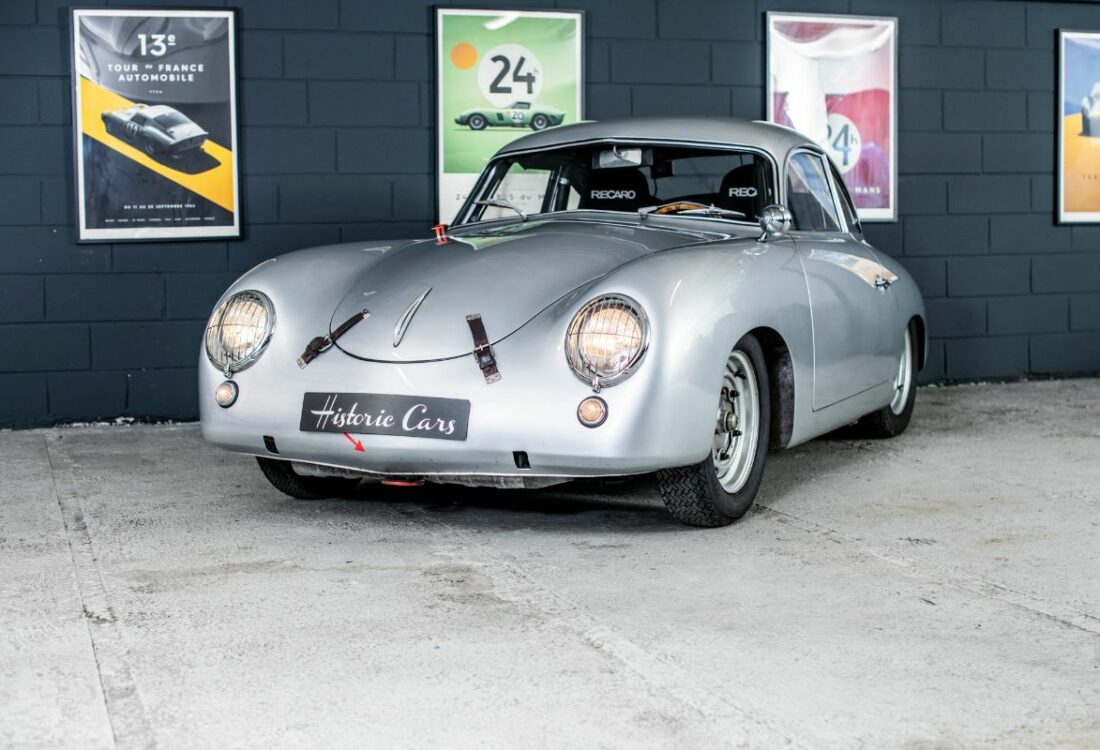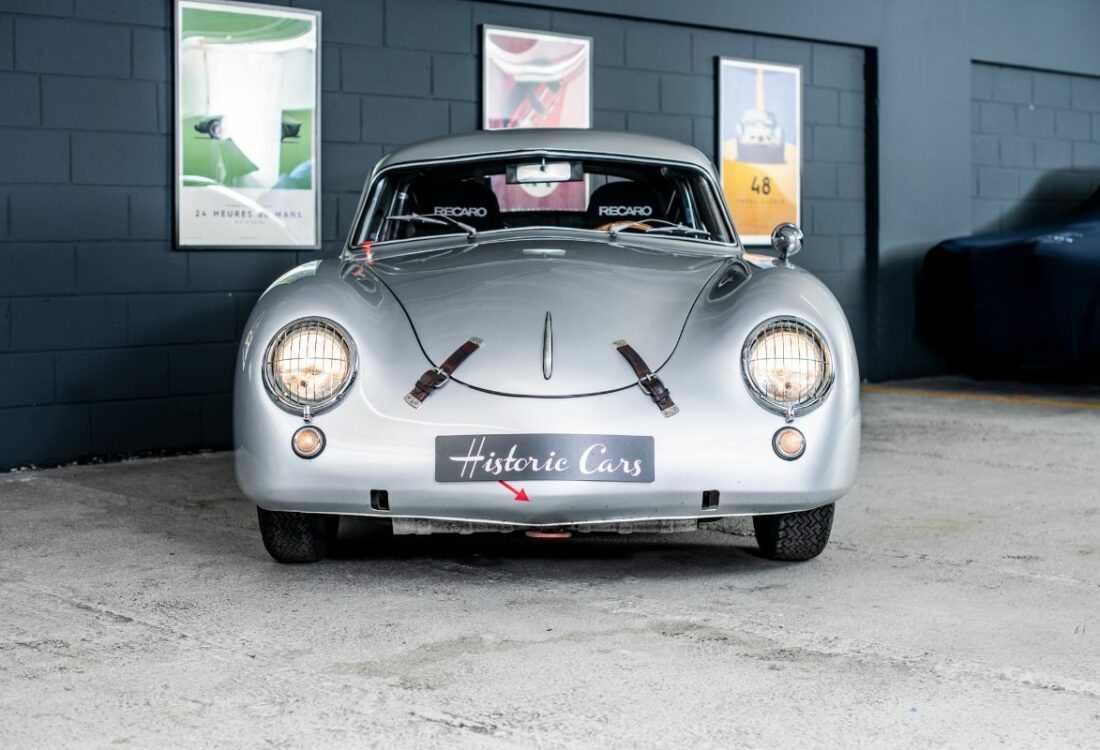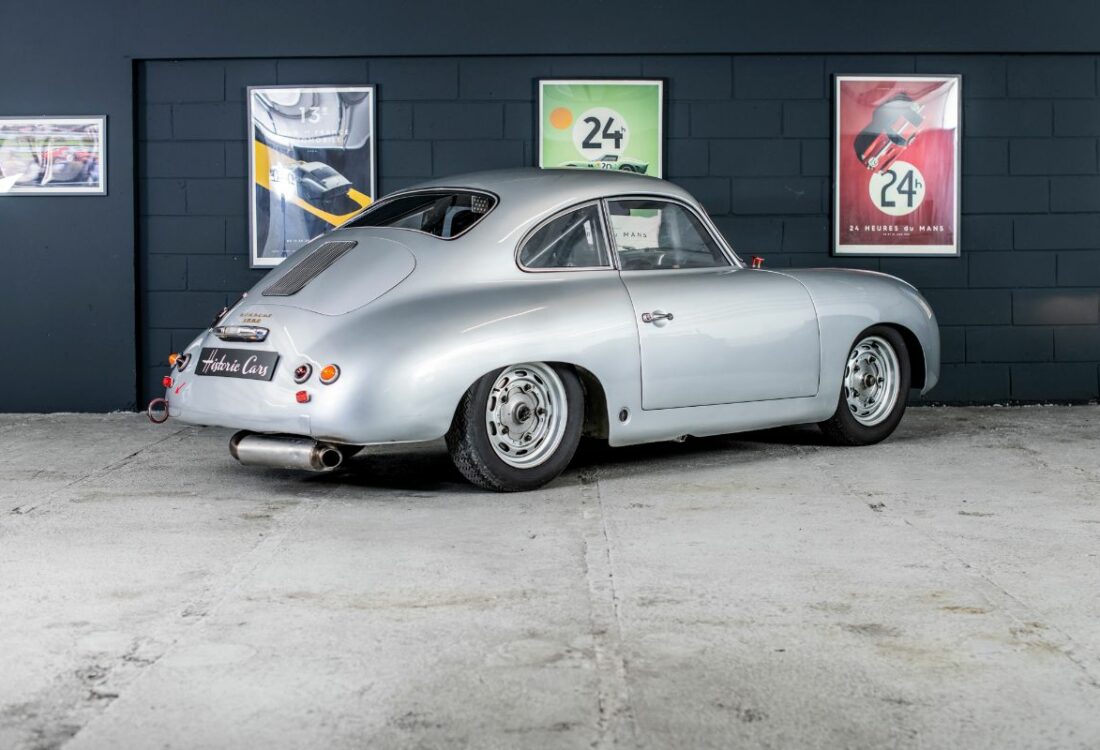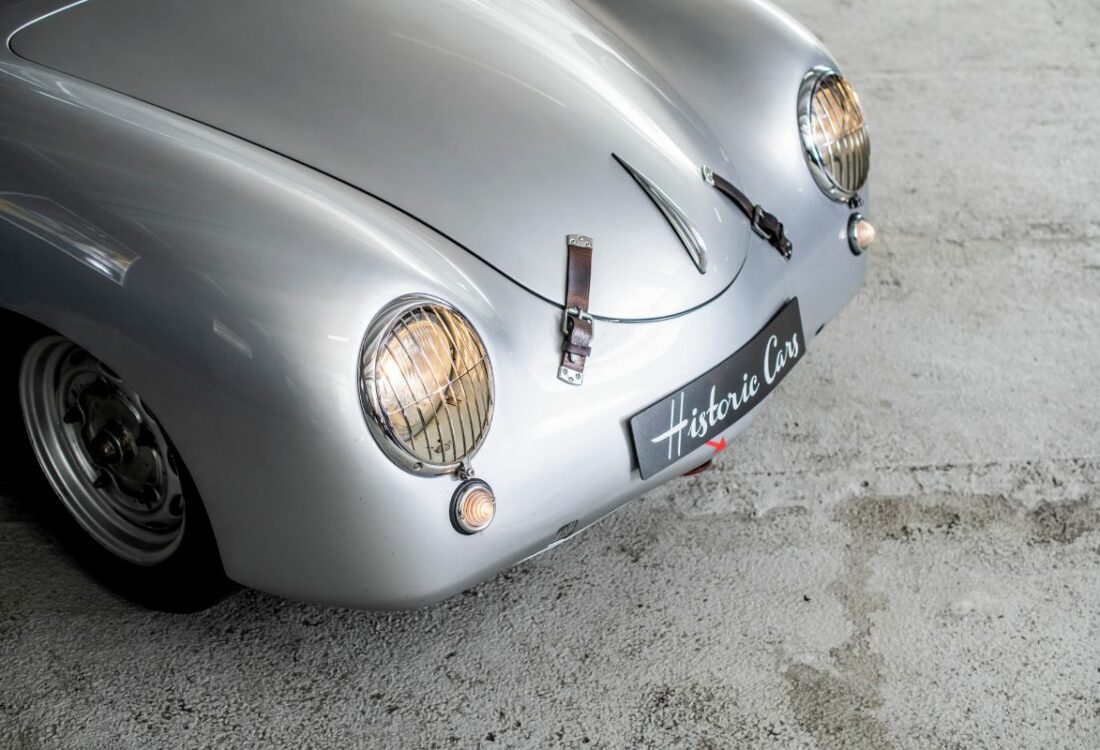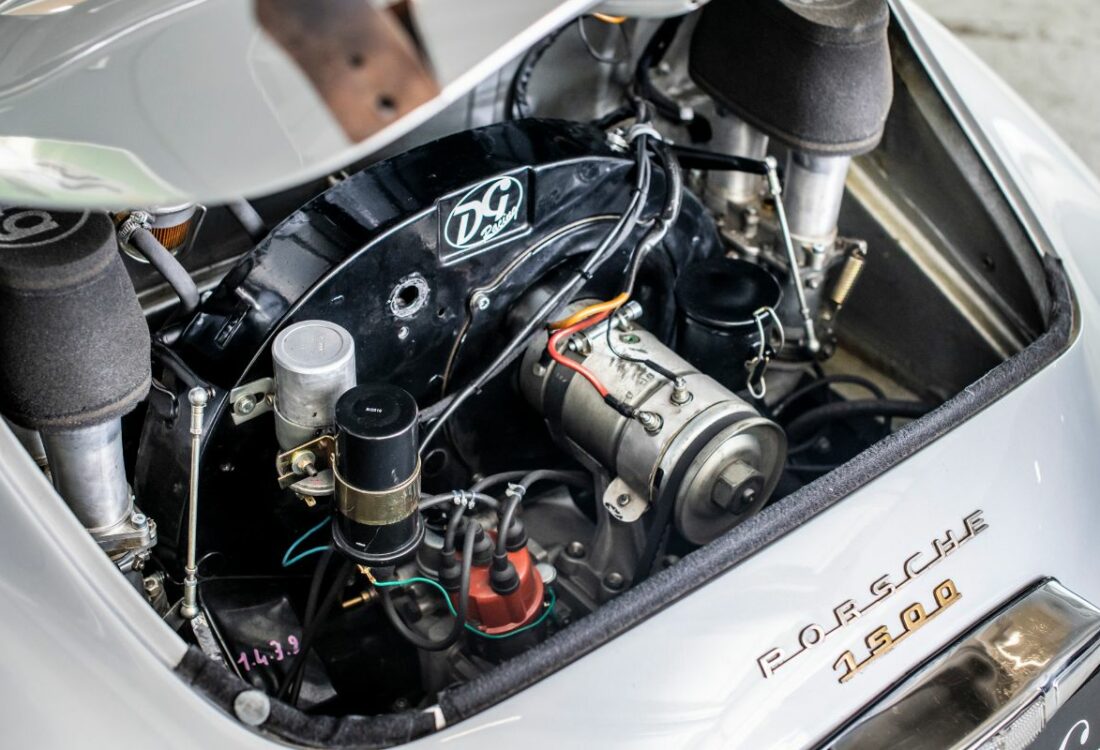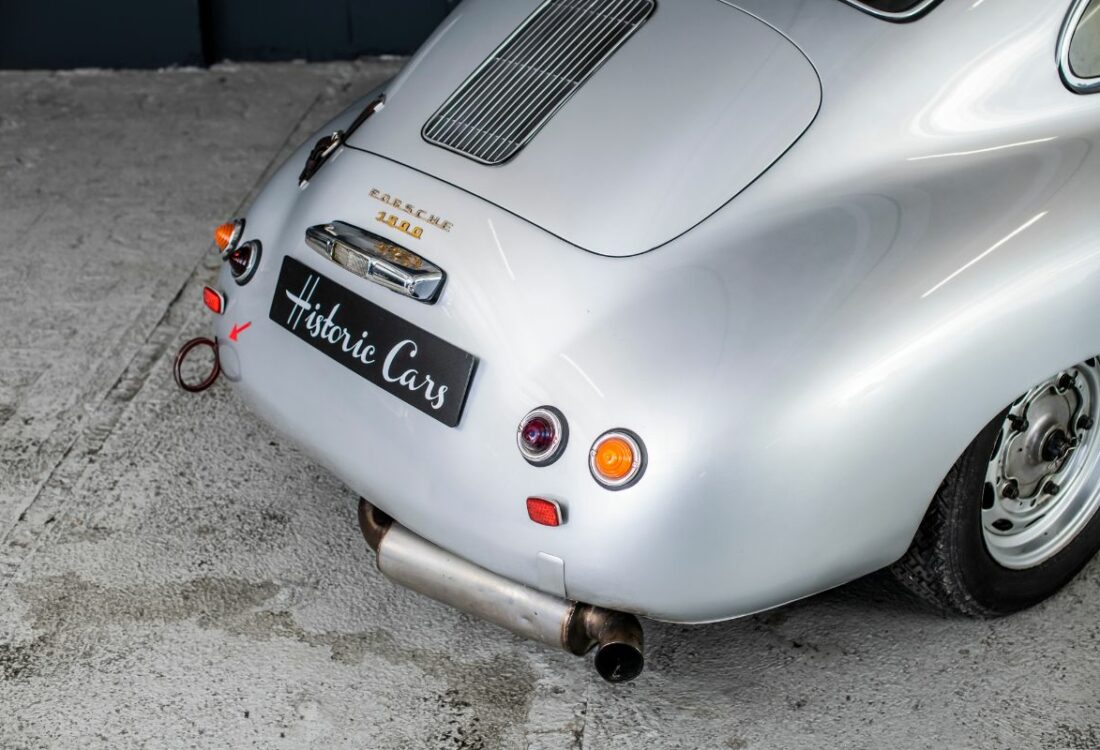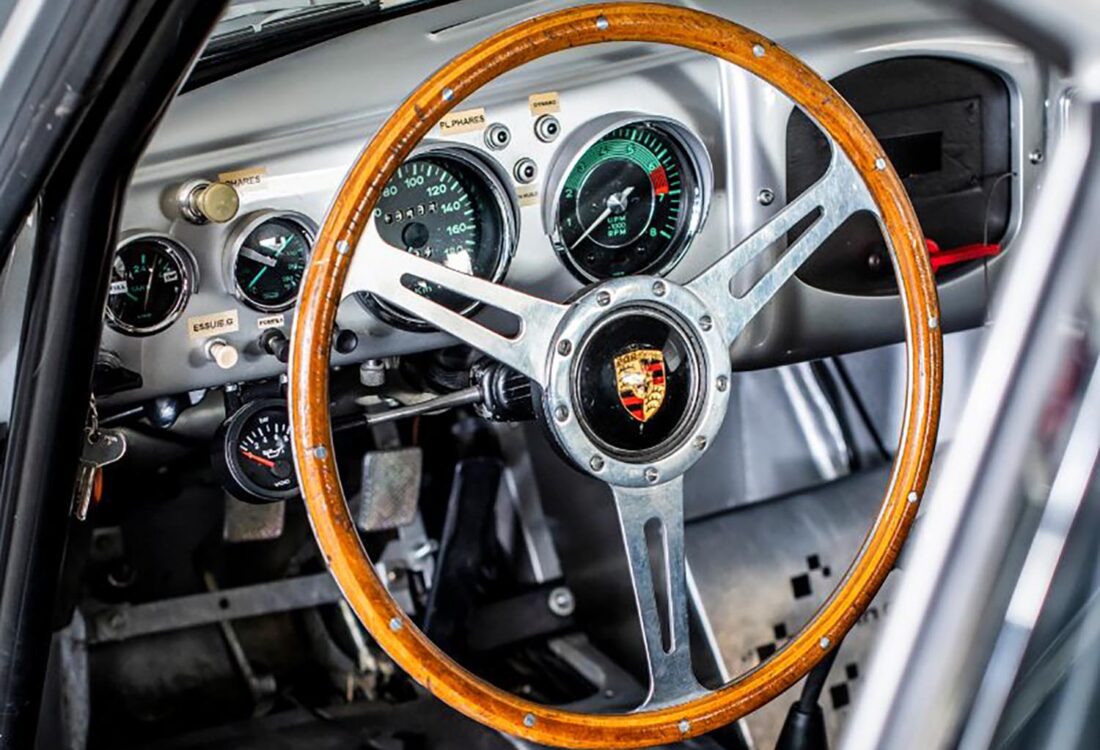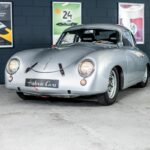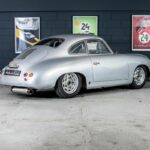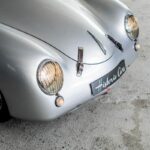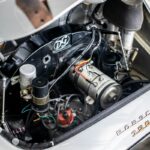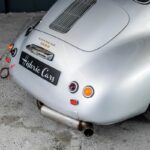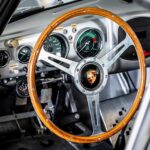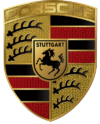
PORSCHE 356 1500 S FIA SPECS GTS [Vendu]
Les services + de Classic Racing
Bientôt disponible
Bientôt disponible
La Porsche 356 occupe une place particulière dans l’histoire de l’automobile, car c’est elle qui a jeté les bases de la légendaire marque Porsche. Née de l’esprit visionnaire de Ferdinand « Ferry » Porsche, la 356 (356ème projet de la marque) est devenue la première voiture de série à porter le nom de Porsche et a ouvert la voie aux voitures de sport emblématiques qui allaient suivre. Lancée en 1948, la 356 a rapidement été reconnue pour son design distinctif, son ingénierie novatrice et ses performances remarquables, consolidant ainsi son statut d’icône classique qui continue de captiver les passionnés du monde entier.
C’est grâce à la 356 que le constructeur a réussi à se faire un nom et à produire les modèles hyperpuissants et prestigieux qu’on connaît aujourd’hui.
Les origines de la Porsche 356 remontent au lendemain de la Seconde Guerre mondiale, lorsque Ferdinand Porsche, le fondateur de l’entreprise, et son fils Ferry cherchent à créer une voiture de sport alliant performances et praticité. Avec des pièces provenant de la coccinelle Volkswagen ; son moteur arrière, son design aérodynamique et sa construction légère sont à l’origine de la série 356 ; le premier prototype Porsche, connu sous le nom de « No. 1 » ou « Porsche 356-001 » voit le jour.
La Porsche 356 a connu plusieurs itérations au cours de sa période de production, de 1948 à 1965. Les premiers modèles, souvent appelés « Pre-A », présentaient un pare-brise en deux parties et divers éléments de design empruntés chez Volkswagen. Au fil des années, la 356 a évolué vers les séries « A » « B » et « C », chacune marquée par des raffinements et des améliorations.
La forme distinctive de la 356, caractérisée par ses courbes élégantes, ses phares ronds emblématiques et sa ligne de toit inclinée, est devenue synonyme d’élégance intemporelle. L’attention portée aux détails dans sa conception, associée à une ingénierie de précision, a contribué à l’attrait durable de la voiture.
Aux Etats-Unis, cette différence prend une ampleur encore plus particulière et devient une véritable opposition car on ne peut imaginer deux types de voitures plus antinomiques qu’une américaine et une 356. Bien que se situant aux antipodes de l’American Way of Driving, elle va conquérir le marché d’outre-Atlantique.
Très vite la Porsche 356 a gagné ses galons sur les circuits, établissant Porsche comme une force avec laquelle il faut compter en sport automobile. Les succès remportés lors d’épreuves telles que les 24 heures du Mans, les Mille Miglia et la Carrera Panamericana ont mis en évidence la fiabilité, la vitesse et les performances globales de la 356. Toutes ces victoires en course ont joué un rôle crucial dans l’élaboration de l’identité de la marque et ont contribué à la popularité de la voiture auprès des passionnés de pilotage sportif.
La réputation de la Porsche 356 a surtout été acquise lors des courses automobiles. Légère, maniable et équipée d’un moteur vif, elle s’est imposée lors de la première édition du « Championnat d’Europe des Rallyes » de 1953. Elle remporte à nouveau cette compétition en 1961, la même année où elle devient victorieuse du « Rallye d’Allemagne ». La Porsche 356 est également victorieuse durant les 4 éditions de la course « Liège-Rome-Liège » (1952, 1954, 1957, 1959). De même qu’elle remporte le « Rallye Press on Regardless » de 1956 ainsi que les éditions de 1960 à 1963 du « Championnat d’Europe de la montagne ».
Bien que la production de la Porsche 356 ait cessé en 1965, son héritage perdure. Le design intemporel de la voiture, associé à son importance historique et à son pedigree en course, en a fait une pièce de collection recherchée, mais aussi pour avoir ouvert la voie aux modèles emblématiques qui ont suivi, notamment la 911.
Ainsi, grâce à une politique de petits pas, qui lui a assuré une lente mais régulière montée en puissance, la 356, née avec 40 ch en 1950, culmine douze ans plus tard à 130 ch avec une cylindrée presque doublée. Le dernier exemplaire de la 356 C quittera la chaîne en avril 1965, soit un an après le lancement de la 911. Mais la 356 se survivra à elle-même à travers ce nouveau modèle qui en constitue une extrapolation.
Avec sa renommée, Porsche finit par séduire certaines personnalités de renom. Parmi les détenteurs de la 356, on peut citer entre autres l’ancien Président français Georges Pompidou et le Roi Beaudoin. Quelques stars hollywoodiennes, comme James Dean, ont également succombé aux charmes de ce modèle emblématique du constructeur allemand.
Notre Porsche 356:
Le propriétaire actuel achète la voiture en 2015 chez Automobilia à Reims, avec pour objectif de participer à des courses historiques telles que le Tour Auto ou le Tour de corse. La voiture est dans une configuration « course » aux spécifications FIA GTS équipé » d’un moteur 136cv et d’une boite de vitesses sur mesure.
La voiture évoluera au fils des courses notamment chez DG Racing à Yenne, où le moteur a été refait dernièrement. Notre 356 compte plusieurs participations au Tour Auto dont une victoire de l’indice de performance en 2022. Elle est désormais vendue prête à courir avec une boite révisée.
Eligible pour les grands événements historiques Tour Auto, Le Mans Classic… cette voiture est l’arme absolue pour remporter l’indice de performance.
![]() 1954 Porsche 356 S, FIA SPECS GTS offered for sale.
1954 Porsche 356 S, FIA SPECS GTS offered for sale.
The Porsche 356 occupies a special place in automotive history, as it laid the foundations for the legendary Porsche brand. The brainchild of the visionary Ferdinand ‘Ferry’ Porsche, the 356 (the brand’s 356th design) became the first production car to bear the Porsche name and paved the way for the iconic sports cars that would follow. Launched in 1948, the 356 quickly became recognized for its distinctive design, superb engineering and outstanding performance, cementing its status as a classic icon that continues to captivate enthusiasts around the world.
It was thanks to the 356 that the manufacturer succeeded in making a name for itself and producing the hyper-powerful and prestigious models we know today.
The origins of the Porsche 356 date back to the aftermath of the Second World War, when company founder Ferdinand Porsche and his son Ferry set out to create a sports car that combined performance and practicality. Using parts from the Volkswagen Beetle, the first Porsche prototype, known as « No. 1 » or « Porsche 356-001 » was created : using its rear engine, aerodynamic design and lightweight construction as the basis of the 356 series.
The Porsche 356 went through several iterations during its production period, from 1948 to 1965. The first models, often referred to as « Pre-A », featured a two-piece windscreen and various design elements borrowed from the Volkswagen Beetle. Over the years, the 356 evolved into the ‘A’, ‘B’ and ‘C’ series, each marked by refinements and improvements.
The distinctive shape of the 356, with its elegant curves, iconic round headlights and sloping roofline, has become synonymous with timeless elegance. The attention to detail in its design, combined with precision engineering, has contributed to the car’s enduring appeal.
In the United States, this difference takes on a particular significance and becomes a real opposition, as it is hard to imagine two types of cars more antinomic than an American car and a 356. Despite being at the opposite end of the American way of driving, it was to conquer the market on the other side of the Atlantic.
The Porsche 356 quickly earned its stripes on the racetrack, establishing Porsche as a force to be reckoned with in motor sport. Successes in events such as the 24 Hours of Le Mans, the Mille Miglia and the Carrera Panamericana highlighted the 356’s reliability, speed and overall performance. All these race victories played a crucial role in shaping the brand’s identity and contributed to the car’s popularity with sports driving enthusiasts.
The reputation of the Porsche 356 has been earned above all in motor racing. Light, maneuverable, and equipped with a lively engine, it won the first edition of the « European Rally Championship” in 1953. It won the competition again in 1961 and the same year won the Rally Germany. The Porsche 356 won all 4 editions of the ‘Liège-Rome-Liège’ race (1952, 1954, 1957, 1959). It also won the 1956 Press on Regardless Rally and the 1960-1963 European Hill climb Championship.
Although production of the Porsche 356 ceased in 1965, its legacy lives on. The car’s timeless design, combined with its historical importance and racing pedigree, made it a sought-after collector’s item, but it also paved the way for the iconic models that followed, notably the 911.
Thus, thanks to a policy of small steps, which ensured a slow but steady rise in power, the 356, born with 40 bhp in 1950, culminated twelve years later with 130 bhp and almost double the engine capacity. The last 356 C left the production line in April 1965, a year after the launch of the 911. But the 356 would survive on its own through this new model, which was an extrapolation of it.
With its reputation, Porsche ended up seducing a number of famous personalities. Owners of the 356 included former French President Georges Pompidou and King Beaudoin. Hollywood stars such as James Dean also succumbed to the charms of this emblematic model from the German manufacturer.
Our Porsche 356 1954 in FIA GTS 1500S specs:
The current owner bought the car in 2015 from Automobilia in Reims with the aim of taking part in historic races such as the Tour Auto and the Tour de Corse.
The car is in FIA GTS Race specification with a 136bhp engine and bespoke gearbox. The car will evolve with the races, notably at DG Racing in Yenne, where the engine was recently rebuilt.
Our 356 has taken part in several Tour Auto events, including an index of performance victory in 2022.
It is now sold ready to race with a revised gearbox. Eligible for the major historic events: Tour Auto, Le Mans Classic… this car is the absolute weapon to win the index.
Passeports techniques
| Passeport | ASN | Numéro | Extrait |
|---|---|---|---|
| Passeport Technique (3 volets) |  | ||
| Passeport technique international (PTH) |  |

